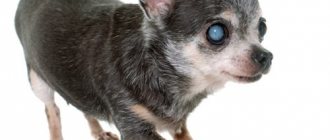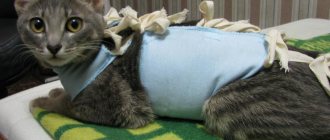Pregnancy in a dog is the physiological state of the female’s body during the period of fruiting. It begins from the moment of fertilization and ends with the birth of mature puppies. Pregnancy in a dog can be singleton or multiple, primary or repeat.
According to their flow they are distinguished:
- Pregnancy is physiological with the normal state of the body of the mother and fetus.
- Pregnancy is pathological with disruption of physiological processes in the body of the mother or developing fetuses.
Development of the embryo and membranes. The zygote, moving along the oviduct to the uterus, quickly splits. First, two blastomeres are formed, then four, eight, etc. A cluster of blastomeres without a separate cavity is called a morula. The zygote in the morula stage enters the dog’s uterus 5-8 days after fertilization. A germinal nodule is formed - the embryoblast, and the outer layer of its cells is the trophoblast (feeding leaf). A fluid and a cavity appear between them, and the morula turns into a germinal vesicle - a blastocyte.
Attachment of the embryo to the mucous membrane of the uterus - induction occurs in dogs from 14 to 21 days. Subsequently, the fetal body is formed from the embryoblast, and the aqueous membrane and placenta are formed from the trophoblast. These are temporary (provisional) organs of the fetus. In bitches, 4 weeks after fertilization, the embryo is surrounded by fully developed membranes: aqueous, urinary and vascular.
The aqueous membrane (amnion) is the innermost membrane without blood vessels. The bladder, which contains the fetus, surrounded by amniotic fluid, fuses with the fetus in the navel area. In carnivores, the amnion is surrounded on all sides by the inner layer of the urinary membrane. The epithelium of the aqueous membrane produces amniotic colorless fluid - 8-30 ml. The liquid contains protein, sugar, fat, estrogenic hormones, mineral salts and other substances. Ingestion of amniotic fluid by the fetus supports water metabolism and ensures the development of the gastrointestinal tract. The water bladder also performs a buffer function, softens and prevents mechanical effects on the fetus, and during childbirth facilitates its removal.
The urinary membrane (allantois ) starts from the top of the fetal bladder and exits through the umbilical ring in the form of the urinary duct (urachus), which is part of the umbilical cord. Expanding funnel-shaped, the urachus forms a cavity in the urinary membrane, in which fetal urine accumulates.
In a dog, the urinary membrane is located between the aqueous and vascular membranes, fused with them, forming the allanto-amnion and allanto-chorion. By the end of pregnancy, the amount of urinary fluid in dogs is 10-15 ml. The role of the allantois is similar to that of the water membrane.
Choroid (chorion) and placenta. The choroid is the outermost, surrounding the fetus on all sides. On its outer surface there are villi, consisting of connective tissue covered with a layer of epithelial cells. The villi are embedded in the recesses of the uterine mucosa (crypts).
The placenta is a complex of tissue formations on the choroid of the fetus and the mucous membrane of the uterus, through which the fetus communicates with the mother’s body and exchanges substances between them.
In dogs, the chorion has an oblong shape, resembling a large cucumber. The chorionic villi come into direct contact with the endothelium of the uterine capillaries, as a result of which the placenta of carnivores is classified as endothelial-chorionic. During childbirth, separation of the fetal placenta in dogs is accompanied by partial rejection of the maternal part of the placenta, which leads to slight bleeding.
A significant amount of biliverdin (a green pigment) accumulates in the placenta of dogs, which is released when the placenta is separated and a green discharge appears.
The umbilical cord in puppies contains two arteries and veins. The length of the umbilical cord is on average from 6 to 10 cm.
Fetal development. At three weeks - length 1 cm, all organs are plugged. The abdominal cavity is closed. View outlines are drawn. Four weeks - 4 cm, species characteristics are quite clearly expressed. Six weeks – length 6-10 cm, individual hairs on the skin are noticeable. Nine weeks - mature fruit 8-20 cm, weight 100-150 g, short hair covering the entire body, eyelids closed, skull bones not fused, no teeth.
Changes in the mother's body during pregnancy. As many corpora lutea develop in the ovaries as the number of egg follicles have matured and ovulated. The uterus is developing rapidly, muscle fibers lengthen by 7-12 times and thicken by 3-5 times. Arteries and veins expand 4-5 times and lengthen, new vascular branches appear. A plug of thickened mucus forms in the cervix, preventing infection from entering. The walls of the uterus form expanded areas (ampoules) of a round shape around each fetus, then as the fetuses grow, they acquire an oval shape, and at the end of pregnancy the boundaries between them gradually smooth out.
With a small number of fetuses, the horns of the uterus form a loop in the abdominal cavity, reaching the diaphragm and liver. If there are a lot of fetuses, a second loop of uterine horns may appear, convexly facing the pelvis. Thus, the uterus can form up to six layers lying in rows. If there is only one fruit, it lies in the ampulla-shaped extension of the cranial part of the horn. In dogs, pregnancy can last 59-70 days.
How long does pregnancy last for different dog breeds?
It is impossible to answer the question of how long pregnancy lasts in dogs. It all depends on the breed of the pet. It is worth considering specific cases. If you are the owner of a large breed, then the average duration of pregnancy in dogs lasts about 63 days.
There are cases when the appearance of puppies took place in the early (50-55 days) and late (70-72 days) periods. The offspring were healthy, strong and strong. There is one reason why the length of pregnancy may change. It lies in the number of puppies that are in the womb. Scientists have proven the fact that dogs of large breeds give birth to fewer puppies, unlike small pets.
If you are the owner of smaller breeds, then be prepared that the duration of pregnancy will be about two months (60-62 days). The number of puppies in the womb can be several units. You can resort to ultrasound examination services. Later in pregnancy, the veterinarian can feel them and count them.
Care and nutrition after childbirth
Even if the dog felt good before giving birth, this many-hour process is very tiring and exhausting for her. She is weakened and now feels additional concern for her offspring. However, you should try after a while, even if forcefully, to take her out for a very short walk. After a walk, pay special attention to cleanliness - wash your paws and belly thoroughly with soap, wipe dry with a towel, and after that you can place the dog with the puppies, which you have already moved to the prepared place for their stay.
Do not forget that a dog after giving birth requires abundant and frequent nutrition. However, the first meal should take place approximately 7-8 hours after the last puppy emerges. We recommend offering it with rice milk porridge, well boiled, with sugar and butter. In the future, be sure to saturate the diet, in addition to regular food, with sweetened tea with milk.
Signs of an “interesting” situation in a pet
When you have a little idea of how long the “interesting” situation lasts, it’s worth moving on to pressing issues and their solutions. An experienced veterinarian can easily recognize signs of pregnancy in dogs. But the owners of their pets also want to determine that their pet will become a mother.
It’s worth remembering one thing right away: you shouldn’t expect any changes in the first days or even weeks after mating. In most cases, after successful fertilization, estrus may occur. And this is considered normal. If you wish, you can do a test and determine whether there is a long-awaited pregnancy or not.
Primary signs
After about 20 days of mating, the following warning signs of pregnancy may appear:
- slight apathy;
- the pet spends more time sleeping;
- the dog stops playing and having fun;
- becomes phlegmatic.
You can understand that a dog is pregnant for other obvious reasons, for example, a positive test. Or:
- Toxicosis. On average it lasts about 7-10 days. As a rule, this condition is not considered dangerous to the health of the bitch and future offspring. Toxicosis occurs in the morning hours. To somehow help your furry household cope with the problem, you can give soft food in small portions.
- Change in appearance. Pregnancy in dogs can also be determined using this method. This usually happens at the end of the first month. Swelling of the mammary glands and discoloration are observed.
Secondary signs
Nothing here can hide from the owner’s gaze. Pregnancy can be determined by the following signs:
- darkening of the mammary glands;
- increasing them in size;
- the dog’s belly becomes noticeable and large;
- increased appetite even among “little ones”;
- changing your waist size, if, of course, you measured it immediately after mating;
- change in the pet’s character, in some cases dogs become aggressive;
- You can feel the fruits with your hand (about 40-45 days).
The entire pregnancy of a dog can be divided into several stages:
Stage 1: Up to 14 days, fertilized embryos move into the uterus and become attached to its walls.
Stage 2: After successful completion of the first stage, from about the 15th day the growth of embryos and the formation of their internal organs begins. Experts consider day 24-25 to be the best time to conduct the first ultrasound. By this time, the average size of the embryo reaches 1 cm.
Stage 3: The middle of pregnancy - day 32 - can be considered the stage of transition of the embryo into the fetus. Now the growth of the fruit will be accompanied by a gradual growth of the abdomen. Don’t forget that a dog’s first birth requires special attention because it causes increased anxiety. In dogs with light skin, you may notice swelling of the skin on the abdomen in the area of the nipples and the nipples themselves.
Stage 4: On the 50th day, the dog’s weight and abdominal size increase significantly. Using X-rays, you can accurately determine the number of fruits - the skull and ribs of the fruit are clearly visible. If the examination shows a large number of fruits, then professional help cannot be avoided. In addition, if this is the owner’s first experience of receiving a litter, then it is also recommended to agree in advance with a specialist who will arrive as soon as the dog’s labor begins.
Stage 5: A few days before giving birth, around the 58th day, a dog that has already given birth begins to produce colostrum or even milk. In a young bitch, colostrum may appear literally a few hours before giving birth.
Dog pregnancy by week
A lot has passed from the search for the ideal father to the appearance of the first signs of pregnancy and a positive test. To have at least some idea of how the process of puppies’ formation takes place, we suggest studying the dog pregnancy calendar by day with a photo of the developing embryo.
| Term | Description | |
| 1 week (0-7 days) | The main actions during this period are:
The bitch got pregnant. Changes in diet and physical activity are undesirable for your pet. It’s worth starting to mix special supplements and vitamins into your food. You can try to do a test. Pregnancy proceeds unnoticed. | |
| 2 week (7-14 days) | The eggs develop into puppies. By the end of the second week, all embryos have descended into the uterus. Physical activity and feeding remain at the same level. If the test does not give results in the first week, you can repeat it. | |
| Week 3 (14-21 days) | The cells are growing every day. Completely move into the uterus. Physical activity and feeding remain at the same level. | |
| Week 4 (21-28 days) | Depending on the experience of the breeder, you can use your fingers to feel the puppies. You can always contact a veterinarian. The nipples swell and a small clear discharge begins from the vagina. We protect the dog from physical activity, training and games. The veterinarian will tell you what food should be at the 4 week stage. | |
| Week 5 (28-35 days) | The amount of amniotic fluid increases. Puppies develop paws, claws, and whiskers. The bitch is actively gaining weight during this period. Feeding is recommended frequently, but in small portions. You can do an ultrasound to identify developmental defects in the early stages and, as a last resort, terminate the pregnancy. | |
| Week 6 (35-42 days) | An interesting situation becomes obvious to everyone around you even without a pregnancy test. Puppies develop coat color and pigmentation. It's time for the owners to start making the lounger. Now the expectant mother needs to be laid only in this place. | |
| Week 7 (42-49 days) | The bitch begins to shed. At this time, the puppies are considered fully formed. It is necessary to give special food in such quantities that the dog can eat at one time. Be sure to include calcium in your animal's diet. | |
| Week 8 (49-57 days) | From this moment on, puppies can be expected at any time of the day or night. Exercises and other stimulation of labor are strictly prohibited. Towards the end of this period, colostrum begins to form. Feeding the dog is carried out in the same mode. | |
| Week 9 (57-65 days) | Childbirth is invariably close. Since they take place at home, then everything must be prepared. To at least somehow control the process, start measuring your temperature several times a day. Feeding in the same mode. If there is a delay of more than 60 days, we carry out the control procedure not only during the day, but also at night. Look at the photos of newborn puppies. |
This is how the whole process goes day by day when a pet is carrying puppies. A dog's pregnancy goes quickly, but during this period you need to be extremely careful and careful.
First signs of labor
The release of colostrum from the nipples should already serve as a signal for the beginning of the owner’s moral preparation to accept the birth of a dog. The bitch also shows changes in behavior - she becomes more restless, looks for a secluded place, scratches the floor, etc.
A day or several hours before the onset of labor, the dog may completely lose its appetite, its breathing becomes heavier and more intermittent, it appears as if groaning, it constantly walks from side to side, showing restlessness. But even at such a moment, much depends on the individual characteristics of the breed or a particular dog. For example, the owners of many cockers note that their pets happily eat literally a few hours before giving birth.
A harbinger of the onset of labor is a slight trembling caused by cramping attacks and the loss of amniotic fluid. At this point, you should be fully prepared to assist your dog and not leave his side at all times. And the doctor will help make the birth as safe as possible for both the mother and the newborn puppies.
Features of pregnancy
This time cannot be considered a disease. The dog also needs to be walked regularly. The longer the period, the walks should become short but frequent. The main thing is to monitor your physical and psychological condition. At the slightest deviation from the norm, you should immediately contact a veterinarian.
Calendar calculator
To at least somehow try to plan the birth and find out its approximate onset, a calculator calendar will help. It is compiled taking into account the fact that the average pregnancy period lasts 62 days. Additionally, such a calendar will help you figure out when your due date will be.
How many puppies does a dog carry in its belly?
In order to understand how many puppies a pet has, it is worth remembering the breed. Small individuals have litter that is much different from their larger counterparts. Large breeds can produce 10 or more puppies.
In order to find out accurate information, you need to go to a veterinarian. Since he can tell without a test that a dog is pregnant, he can easily find the number of all individuals. In addition, ultrasound will always come to the rescue.
What to do after the birth of puppies?
Take time off from work so you can spend as much time at home as possible. This way you can observe how the bitch behaves, especially if this is her first litter. Note for yourself the important moments of your mother’s behavior. If you plan to regularly breed puppies in the future, the experience gained will be invaluable to you.
During a normal birth, and if the bitch is already experienced, it will not be difficult to care for the babies, since from birth they already have certain reflexes . An adult dog has a very strong maternal instinct. If this is not the first litter, the bitch will carefully look after the children, carefully licking them, protecting them and feeding them.
Caring for a dog in position
- Proper nutrition. The diet should include not only homemade food, but also special food with vitamin supplements. The presence of calcium is especially valuable.
- If, nevertheless, the choice is made in favor of natural food, then increase the amount of meat, cottage cheese and offal.
- In the first weeks, do not deny your pet the pleasure of running and jumping. But from the middle of the first month, it is better to stop physical exercise and training and let your pet enjoy peace of mind.
- You can't overfeed your dog.
- 24-hour access to fresh drinking water.
Caring for a pregnant dog is practically not much different from caring for a human dog.
Feeding newborn puppies
Puppies often do not gain weight in the first few days.
Puppies are born with an innate sucking reflex. However, weak babies who are unable to latch on to the nipple themselves must be held until they have received their share of milk. Apply them to the fuller nipples. First, knead the bitch's chest and express the colostrum so that the puppy can smell it. So he will need to be fed for several days. Then the puppy will get a little stronger and will be able to feed on its own.
Useful information: Healthy babies know how to grasp the nipple tightly, they lift their tails up, sleep well, and have wet noses. If there are lethargic and inactive ones, they need to be shown to a veterinarian.
It is very important to weigh a newborn puppy and subsequently monitor how he gains weight and how much food he takes at a time . If the baby is very weak and cannot suck even a drop on his own, he will need to be fed every 1.5 hours from a pipette, syringe or pacifier. To do this, express the mother's milk and give it to the puppy little by little. For the first time, 1 milliliter will be enough.
When the puppy grows a little, increase the amount of milk to 5-10 milliliters. This can only be done after 2 weeks.
Often, in the first few days after birth, babies do not gain weight, and sometimes they can even lose a little weight. But after a couple of days, positive dynamics should appear. If this does not happen, it means that the bitch does not have enough milk to feed the children. You will have to additionally feed the growing body
Often the mother has an excess of milk that remains after feeding. To avoid congestive mastitis, regularly examine your dog's chest and express any excess. This may be due to the fact that she gave birth to only one puppy, which simply cannot suck all the milk. The nipples most commonly pulled by puppies can be swollen, hard, and hot. Owners who encounter a brood for the first time sometimes forget to examine the upper glands, which the babies do not touch. However, milk may also remain there; you need to keep an eye on this. Check all nipples regularly, massage them and express any remaining milk.
Abortion
It happens that the breeding of a dog is not planned at all by the owner. In such cases, you have to resort to a procedure such as abortion. Pregnancy can also be terminated for medical reasons from a veterinarian. The procedure is carried out regardless of the stage of pregnancy. First, it’s worth finding out whether there was a mating. They do a special analysis of the dog's vagina.
No matter what stage of pregnancy the dog is in, the veterinarian will provide conservative treatment. Its type depends on the stage of pregnancy:
- First month. Abortion is difficult due to unclear picture. Most often, medications are used during this period.
- End of the first weeks. The pregnancy test will definitely be positive. The fruits are sucked out or expelled from the pet's belly.
- Mid and end of the second month. The veterinarian first calcifies the bones of the puppies, and then simply expels them from the womb.
Sorry, there are no surveys available at this time.
Thermoregulation of newborn puppies
In the first week of life, babies do not have a proper thermoregulation system. Even if they are cold, their body will not tremble. So you will have to monitor the temperature in the bed if they grow up separately from their mother, or make sure that they are always close to their mother. To keep the temperature normal and the puppies not to freeze, it is necessary to place them close to each other. If the cot is colder than +30°C, there is a chance that the babies will freeze.
Short-term mild hypothermia will not harm the puppy’s health, but, on the contrary, will strengthen the immune system. This way the puppy will gradually get used to growing in natural conditions. But longer hypothermia can threaten the puppy's life. This problem can be solved by placing an electric heating pad in the baby's bed. Remember that it does not need to be installed over the entire area where the puppies live. If the bitch gets hot, prepare a place where she can move without leaving the children.
Video "Pregnant dogs"
The video says that pregnancy and a dog in the house are happiness.
Was this article helpful?
Thank you for your opinion!
The article was useful. Please share the information with your friends.
Yes (50.00%)
No (50.00%)
X
Please write what is wrong and leave recommendations on the article
Cancel reply
Rate the benefit of this article: Rate the author ( 4 votes, average: 4.75 out of 5)
Discuss the article:
General advice for the owner of a dog giving birth
- You need to prepare for childbirth with responsibility and attention - this is stress for the dog’s body. It is better if everything takes place under the supervision of a veterinarian or a person who has experience in obstetrics.
- For a dog, childbirth is a lot of stress, especially for first-time dogs. The dog owner can help the pet, calm it down with affection and stroking.
Attentive attitude towards your pet is the main help that a dog owner can provide. In other cases, only a veterinarian will help, because in a matter such as childbirth, unqualified intervention can cost not only the health of the puppies, but also the life of the mother dog.
3 / 5 ( 3 voices)











